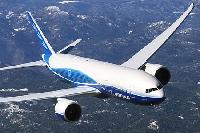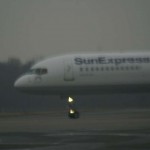The Boeing Company [NYSE: BA] announced today that its 777 jetliner fleet has completed its 1 millionth flight under regulations for extended operations (ETOPS). Based on reported and projected 777 fleet data, Boeing estimated the 1 millionth 777 ETOPS flight occurred on May 11.
„The 1 millionth 777 ETOPS flight is a result of our point-to-point product strategy to develop airplanes that fly people directly where they want to go,“ said Larry Loftis, vice president-general manager, 777 Program, Boeing Commercial Airplanes. „Early in its development we set out on a deliberate path to make the 777 the first airplane to enter service ready to fly ETOPS routes.“
Under ETOPS regulations, airplanes are allowed to fly long-distance routes that take far them from the nearest airport. The 777 was designed specifically to have the reliability and redundancy to safely traverse those long-distance routes governed by extended operations rules. The 777 was also the first twin-engine airplane to fly routes over the new North Polar Routes between the U.S. and Asia that began in 2000.
„Following the success of 767 ETOPS flights, the 777 has further proven the safety and reliability of twin-engine airplanes for long-haul flights,“ said Loftis. „Today, Boeing twin-engine airplanes serve the majority of routes that cross the Atlantic and they are beginning to dominate routes across the Pacific as well.“
The introduction of the 777 has helped lead to an increase in trans-Pacific routes that connect city pairs with nonstop service. Since 1995, city pairs served with direct trans-Pacific routes have increased by about 50 percent.
For passengers, ETOPS provides them the direct, nonstop flights they prefer, in addition to more flight options and greater choice in travel times, Loftis added.
The journey to reach 1 million ETOPS flights for the 777 began with its entry into service on June 7, 1995. The first revenue-generating flight for the 777 was a trans-Atlantic ETOPS flight by United Airlines. To date, the 777 fleet has accumulated a total of more than 14 million flight hours, the majority on ETOPS flights. The 767 is the only other twin-engine airplane to surpass 1 million ETOPS flights, reaching that milestone in April 1998.
In February 2007, the U.S. Federal Aviation Administration (FAA) enacted ETOPS regulations that update and codify existing rules and best practices and extend ETOPS standards to three- and four-engine airplanes. The new regulations also shift the basis of ETOPS approvals to the designed and certified capabilities of the airplane itself, setting the stage for properly configured and approved twinjets to fly optimal routings between virtually any two cities on earth. Boeing has stated its objective is to certify some versions of the 777 and 787 to 330-minute ETOPS.
The 777 family of airplanes is popular with passengers and airlines because of its fuel-efficient twin-engine design, high reliability, low operating costs and spacious cabin interior. The 777 is the market leader in the 300 to 400-seat segment, consistently capturing more than 65 percent of that market since its launch. Boeing continues to enhance the 777 family with the recent introduction of two new longer-range models and a freighter version currently in development. To date, 52 customers around the world have ordered 952 777 jetliners.
A map indicating 777 ETOPS routes around the world is available here.






